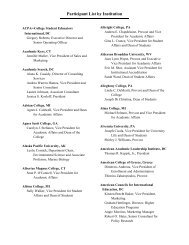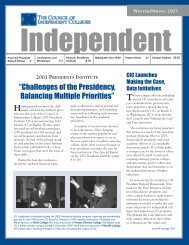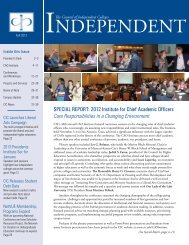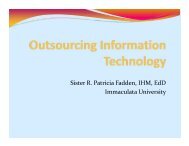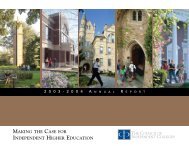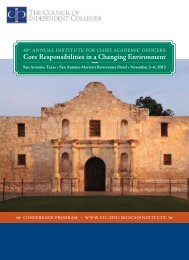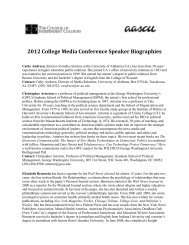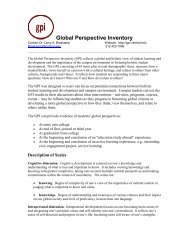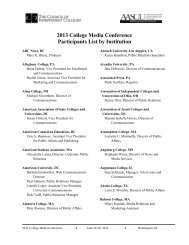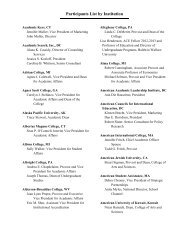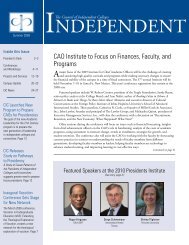Meeting the Challenge: - The Council of Independent Colleges
Meeting the Challenge: - The Council of Independent Colleges
Meeting the Challenge: - The Council of Independent Colleges
You also want an ePaper? Increase the reach of your titles
YUMPU automatically turns print PDFs into web optimized ePapers that Google loves.
Alvin P. San<strong>of</strong>f<br />
“Agnes Scott College is a place that helps women<br />
achieve <strong>the</strong>ir highest expectations.”<br />
—Mary Brown Bullock, President, Agnes Scott College<br />
Cedar Crest has doubled in size and now enrolls <strong>the</strong> fulltime<br />
equivalent <strong>of</strong> about 1,700 students, half <strong>of</strong> whom are<br />
traditional undergraduates and <strong>the</strong> rest adult learners. Says<br />
Blaney: “Building our reputation in <strong>the</strong> sciences has brought<br />
about <strong>the</strong> growth.”<br />
Agnes Scott College in Georgia is ano<strong>the</strong>r women’s<br />
college that has enjoyed substantial growth. In <strong>the</strong> past decade<br />
undergraduate enrollment has risen from 600 to 900. Founded<br />
in 1889 as part <strong>of</strong> <strong>the</strong> Presbyterian educational movement,<br />
<strong>the</strong> college’s original mission was to educate women for <strong>the</strong><br />
betterment <strong>of</strong> <strong>the</strong>ir families and <strong>the</strong> elevation <strong>of</strong> <strong>the</strong>ir religion.<br />
It has since widened its vision dramatically. Today, many<br />
graduates enter law, medicine, and o<strong>the</strong>r pr<strong>of</strong>essions and a<br />
number pursue graduate studies. Indeed, measured by <strong>the</strong><br />
proportion <strong>of</strong> graduates who go on to earn <strong>the</strong>ir doctorates,<br />
Agnes Scott ranks in <strong>the</strong> top 10 percent nationally and in <strong>the</strong><br />
top one percent in <strong>the</strong> field <strong>of</strong> economics.<br />
President Mary Brown Bullock, herself a graduate <strong>of</strong><br />
Agnes Scott, describes <strong>the</strong> college as a place that helps women<br />
“achieve <strong>the</strong>ir highest expectations.” Bullock, who has led<br />
Agnes Scott since 1995, says that as <strong>the</strong> college has expanded<br />
<strong>of</strong>ferings in <strong>the</strong> sciences and ramped up its international<br />
programs—about 40 percent <strong>of</strong> students now study<br />
abroad—it has benefited from its location in Atlanta. While<br />
Boston may be <strong>the</strong> first city that comes to people’s minds<br />
when <strong>the</strong>y hear <strong>the</strong> words “university town,” Bullock notes<br />
that 18 colleges and universities in Atlanta form a regional<br />
consortium and that Agnes Scott students can cross-register<br />
at any <strong>of</strong> <strong>the</strong> o<strong>the</strong>r institutions. Because <strong>of</strong> <strong>the</strong> college’s<br />
location, it can guarantee internships to all students, at<br />
institutions ranging from <strong>the</strong> Federal Reserve Bank <strong>of</strong> Atlanta<br />
and <strong>the</strong> federal government’s Centers for Disease Control and<br />
Prevention to many smaller companies run by women. Agnes<br />
Scott <strong>of</strong>fers women an education filled with opportunity that<br />
is both “challenging and engaging,” says Bullock.<br />
Reaching Out to <strong>the</strong><br />
Under-Represented<br />
Ano<strong>the</strong>r school that was established to educate<br />
young women, Mount St. Mary’s College in California, also<br />
continues to serve a student body composed mostly <strong>of</strong> women.<br />
But <strong>the</strong> college, founded in 1925, is best known as one <strong>of</strong> <strong>the</strong><br />
nation’s most ethnically and racially diverse institutions <strong>of</strong><br />
higher education. More than half <strong>the</strong> students in <strong>the</strong> college’s<br />
baccalaureate program are Latina or African-American, and<br />
more than one-fifth are Asian-American. Many <strong>of</strong> <strong>the</strong> college’s<br />
1,800 undergraduates are from lower-income families. About<br />
40 percent are first-generation college students—many from<br />
families whose primary language is not English.<br />
51



